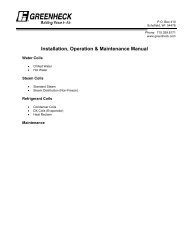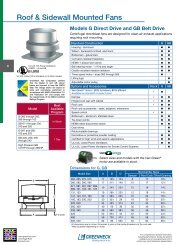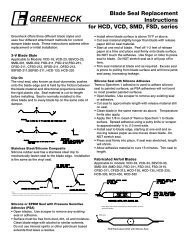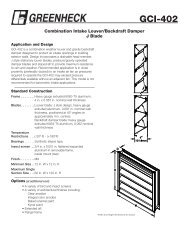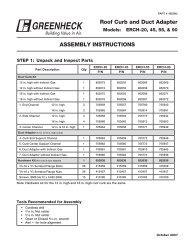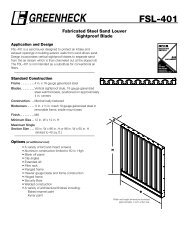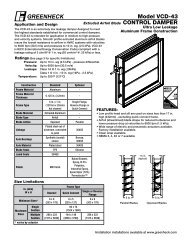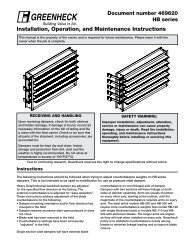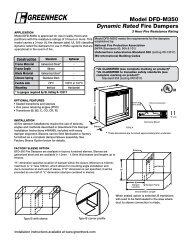Double-Width Centrifugal Fan Performance Supplement - Greenheck
Double-Width Centrifugal Fan Performance Supplement - Greenheck
Double-Width Centrifugal Fan Performance Supplement - Greenheck
Create successful ePaper yourself
Turn your PDF publications into a flip-book with our unique Google optimized e-Paper software.
STEP 1<br />
Enter the performance table with the desired CFM<br />
and Ps. Obtain the fan RPM, BHP and Class.<br />
EXAMPLE<br />
For this example, we will use 13,400 CFM at 2.0 Ps.<br />
This gives us a fan RPM of 1847, requiring 10.9 BHP,<br />
with Class I construction.<br />
NOTE: If your specific fan selection requires inlet<br />
vanes or if the fan operating point is not at standard air<br />
(70°F), refer to the inlet vane and air density correction<br />
factor graphs and tables found on pages 5 and 6.<br />
D<br />
)<br />
0<br />
0<br />
1<br />
x<br />
a<br />
P<br />
(<br />
e<br />
r<br />
u<br />
s<br />
s<br />
e<br />
r<br />
P<br />
c<br />
i<br />
t<br />
a<br />
t<br />
S<br />
40<br />
35<br />
30<br />
25<br />
20<br />
15<br />
10<br />
5<br />
0<br />
Class Max RPM<br />
I 1960<br />
II 2554<br />
III 3219<br />
)<br />
g<br />
w<br />
.<br />
n<br />
i<br />
(<br />
e<br />
r<br />
u<br />
s<br />
s<br />
e<br />
r<br />
P<br />
c<br />
i<br />
t<br />
a<br />
t<br />
S<br />
18<br />
16<br />
14<br />
12<br />
10<br />
8<br />
6<br />
4<br />
2<br />
BIDW-20<br />
25 30<br />
40<br />
3<br />
2<br />
1½<br />
1<br />
DO NOT SELECT TO THE LEFT OF THIS SYSTEM CURVE<br />
800<br />
1100<br />
1400<br />
1700<br />
0<br />
0 2 4 6 8 10 12 14 16 18 20 22 24 26 28<br />
Inlet Sound Power, Lwi<br />
RPM %WOV 1 2 3 4 5 6 7 8 L wi A<br />
550 100 78 75 74 78 68 62 56 52 76<br />
80 76 73 71 75 67 60 54 50 74<br />
60 75 70 70 76 67 60 54 50 74<br />
50 75 69 69 76 67 60 54 50 75<br />
40 74 69 69 77 67 60 54 50 75<br />
800 100 79 91 83 82 76 72 64 60 83<br />
80 80 89 81 78 72 67 59 54 80<br />
60 77 83 76 77 71 67 59 54 77<br />
50 76 80 74 76 71 67 60 55 77<br />
40 77 78 74 76 71 67 60 55 77<br />
1100 100 85 92 91 89 85 81 74 70 90<br />
80 84 88 88 87 81 77 69 65 87<br />
60 83 84 83 83 79 76 70 65 85<br />
50 80 83 82 83 79 76 70 66 84<br />
40 80 83 82 83 78 75 70 66 84<br />
1600 100 91 94 98 95 92 89 83 78 97<br />
80 88 91 96 93 90 86 80 75 95<br />
60 87 88 93 89 86 83 78 75 92<br />
50 87 88 91 88 85 82 78 75 91<br />
40 89 88 90 87 85 82 78 76 90<br />
2200 100 98 100 103 105 98 96 91 88 105<br />
80 95 97 100 103 96 92 87 84 102<br />
60 92 93 98 99 93 91 87 84 100<br />
50 93 93 98 97 93 90 87 84 99<br />
40 95 95 98 98 92 90 88 86 99<br />
3219 100 105 109 110 114 110 106 102 98 115<br />
80 103 106 107 111 107 102 98 94 112<br />
60 100 102 105 107 104 101 97 94 109<br />
50 101 103 105 105 103 100 97 94 108<br />
40 103 105 106 106 103 99 98 96 108<br />
Step 3<br />
E<br />
20<br />
15<br />
10<br />
7½<br />
5<br />
Volume (cfm x 1000)<br />
0 5 10 15 20 25 30 35 40 45<br />
3<br />
Volume (m /hr x 1000)<br />
The sound power level ratings shown are in decibels, referred to 10<br />
23<br />
-12 watts calculated per AMCA Standard 301. Values shown are for inlet Lwi, LwiA and outlet<br />
Lwo, LwoA sound power levels for Installation Type B: free inlet, ducted outlet. Outlet ratings include the effects of duct end correction. The A-weighted sound<br />
ratings shown have been calculated per AMCA International Standard 301.<br />
50<br />
1960<br />
Step 2<br />
2300<br />
<strong>Fan</strong> Selection Procedure<br />
50% WOV<br />
2554<br />
60<br />
60% WOV<br />
Sound Power [dB Ref 10 -12 watts]<br />
2800<br />
3000<br />
F<br />
3219<br />
11<br />
STEP 2<br />
Enter the <strong>Fan</strong> Curve with the desired CFM and Ps.<br />
Obtain the fan operating point, % WOV, Motor HP<br />
and verify fan class by curve shading.<br />
EXAMPLE<br />
For this example, the fan operating point is at<br />
85% WOV using a 15 HP motor.<br />
70% WOV<br />
RPM<br />
BHP<br />
% WOV<br />
Density 0.075 lb/ft 3<br />
Density 1.2 kg/m 3<br />
80% WOV<br />
90% WOV<br />
20 BIDW<br />
% WOV = (CFM X 100) / (RPM X 8.58)<br />
Outlet Sound Power, Lwo<br />
RPM %WOV 1 2 3 4 5 6 7 8 L wo A<br />
550 100 90 78 75 68 67 59 52 47 73<br />
80 90 77 71 64 64 54 47 45 70<br />
60 83 74 68 63 62 54 48 45 67<br />
50 82 73 67 63 63 54 48 45 67<br />
40 82 73 67 63 63 54 48 46 67<br />
800 100 93 96 83 77 77 71 63 57 84<br />
80 90 92 81 73 72 64 57 52 80<br />
60 87 84 76 72 69 63 57 53 75<br />
50 87 82 74 72 68 62 57 54 74<br />
40 89 83 73 71 68 62 57 54 74<br />
1100 100 99 93 90 86 86 80 74 67 90<br />
80 96 92 88 83 81 74 67 61 86<br />
60 91 87 83 78 77 71 66 61 82<br />
50 91 86 82 77 76 71 66 62 81<br />
40 92 86 81 76 75 70 66 62 80<br />
1600 100 105 98 98 94 93 89 85 77 98<br />
80 102 95 96 91 92 87 81 73 96<br />
60 100 91 93 87 87 83 77 72 92<br />
50 100 92 92 86 86 81 76 72 91<br />
40 100 93 92 85 84 81 76 72 90<br />
2200 100 109 105 106 109 102 97 93 88 109<br />
80 107 101 101 105 98 93 89 83 105<br />
60 103 97 96 99 96 91 86 81 100<br />
50 104 98 95 97 94 89 85 81 99<br />
40 107 100 95 95 92 89 85 81 98<br />
3219 100 117 115 113 118 114 108 104 99 118<br />
80 115 112 109 113 110 104 100 94 114<br />
60 111 108 105 107 106 102 97 92 110<br />
50 112 109 104 105 104 100 96 92 108<br />
40 116 112 106 103 102 99 95 92 107<br />
®<br />
STEP 3<br />
Enter the <strong>Fan</strong> Sound Table<br />
with the <strong>Fan</strong> RPM from the<br />
performance table and the %<br />
WOV from the fan curve. Obtain<br />
the eight octave ratings for inlet<br />
(Lwi) and Outlet (Lwo) Sound<br />
Power.<br />
EXAMPLE<br />
For this example, the eight octave<br />
ratings are circled in the table<br />
below.<br />
NOTE: The exact % WOV for your<br />
desired performance can be found<br />
using the equation at the top of<br />
the Sound Power Tables if it is<br />
not published. The eight octave<br />
ratings can then be found using the<br />
interpolation instructions found in<br />
the Sound <strong>Performance</strong> section on<br />
pages 8 and 9.<br />
®




